A Collector’s Guide on Antique Swords
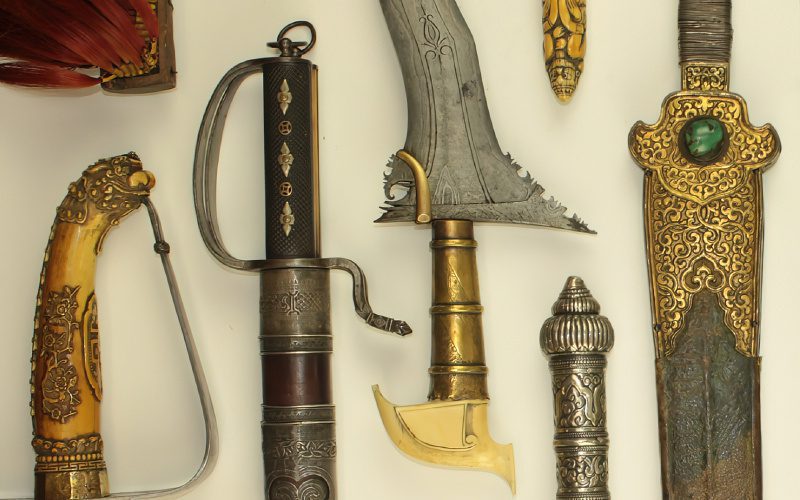
What’s in this article?
Antique swords come from all over the globe and have long been treasured and studied by several collectors, historians, and connoisseurs. Several masterpieces are already in museums, though some are within reach. Some are prized for their historical value, while others are appreciated for their beauty and craftsmanship.
Let’s explore the most sought-after antique swords, their historical background, and factors to consider before buying them.
Types of Antique Swords and Their History
Throughout history, swords served not only as powerful edged weapons, but also as symbols of war, power, justice, and nobility. Many collectors value antique swords based on their historical background and the purpose for which they were used. For example, some of their previous owners may be well-known historical figures or the swords were significant in historical battles or campaigns.
1. Japanese Swords
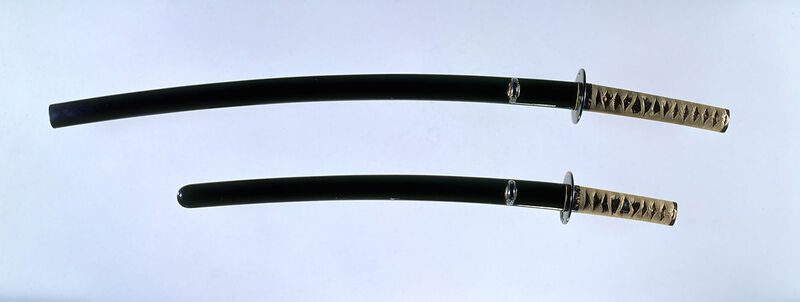
Japanese swords have long been associated with the samurai of feudal Japan, especially the katana sword. The samurai warriors used the katana as a slashing weapon when fighting on foot. It also became customary to wear two swords called daisho, in which the short sword wakizashi accompanied the katana as a backup weapon.
The term nihonto refers to blades made by Japanese licensed swordsmiths using traditional production methods, as opposed to Japanese-styled swords not made in Japan. Many associate it with the long sword katana, though it can also be applied to the wakizashi and tanto dagger. The antique nihonto have artistic value and historical significance, especially if they were forged by a famous swordsmith.
2. Chinese Swords
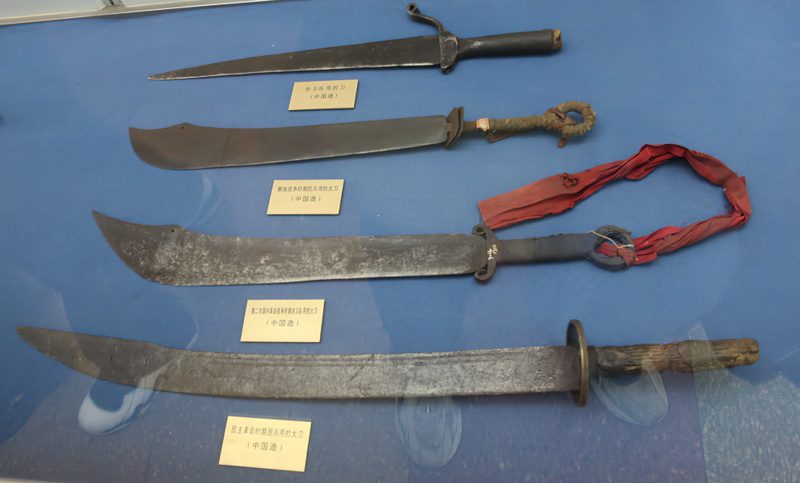
The double-edged jian and the single-edged dao were among the primary weapons of Chinese warriors. The former was more popular than the other though the curved dao was easier and more practical to use.
Many surviving examples date back to the reign of Emperor Qianlong of the Qing dynasty. By the 19th century, the declining Qing Empire developed firearms to match those of Europe, and the role of swords gradually reduced to eventually becoming ceremonial weapons.
Jian
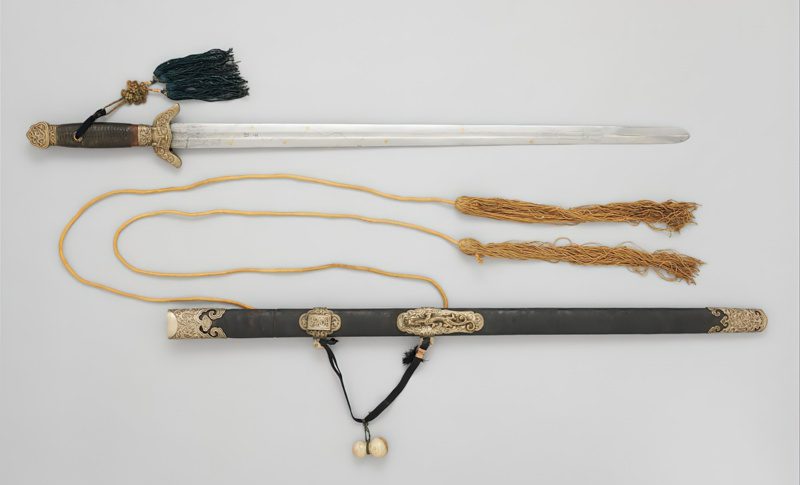
The jian refers to any straight, double-edged Chinese sword, though collectors use various terms to describe their qualities and provenance. It served as a ceremonial sword worn by officers and high officials as part of their regalia. The Chinese also regarded the sword as a symbol of moral values such as honor and honesty.
Dao

The Chinese cavalry preferred the dao over the jian as its curved blade was more efficient for slashing. The term dao describes various single-edged Chinese swords, including the duan dao (short saber), peidao (waist saber), and dadao (cleaver-shaped sword). In Republican China, from 1911 to 1949, the dadao served as combat weapons of Chinese post-imperial resistance fighters.
3. Persian Shamshir

Shamshir refers to the Persian saber with a deeply curved and narrow blade, making it an efficient slashing weapon. It spread from Persia from the 16th century onwards and can also be found in Turkey, India, and other parts of the Islamic world. Many collectors value its craftsmanship, as it was often decorated with gold or silver inlay work and set with precious stones.
4. Indian Talwar
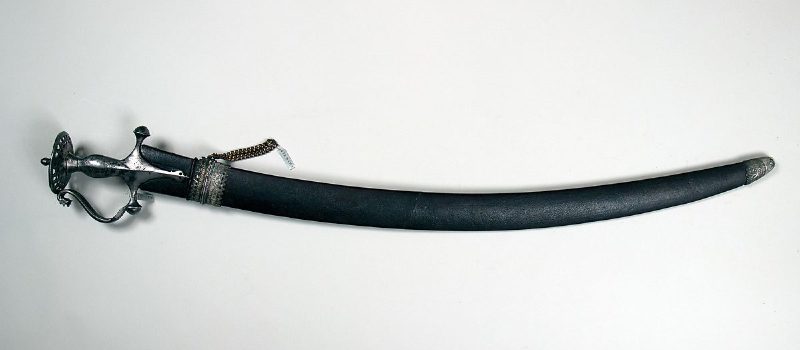
The talwar, sometimes spelled tulwar, was the archetypal sword of Mughal India. It was among the weapons of the Rajputs, traditionally an Indian warrior caste though many later adopted Islam after the Mughals took over.
The talwar also played a role during the wars between Mysore ruler Tipu Sultan in southern India and the British East India Company. British officers also appreciated the quality of these Indian swords, leading many to bring them home as souvenirs, many of which are now displayed in museums.
5. European Hunting Swords
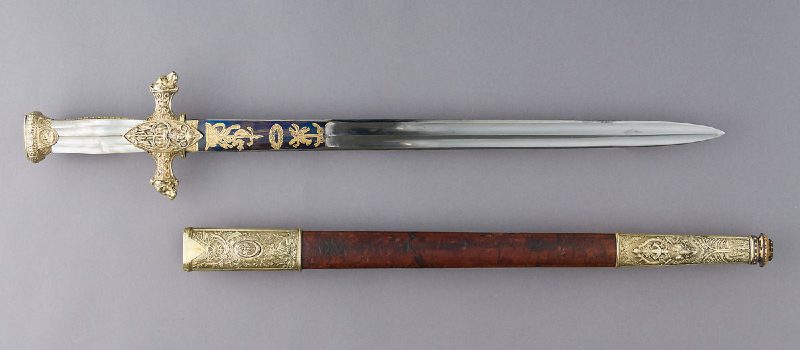
By the 16th century, hunting swords used for finishing off a wounded animal became popular among European aristocrats. Many surviving examples were likely used in hunting, such as for hunting bears or wolves.
These swords were often short enough to be conveniently carried in the forest but elaborately decorated, with some serving a more decorative purpose rather than functional. By the 18th century, hanger-type hunting swords became a model for the ordinary soldier’s fighting sword.
6. European Infantry and Cavalry Swords
From the 16th century onwards, most infantry relied on swords as thrusting weapons, while cavalrymen preferred those that were efficient against mounted and dismounted enemies. Several types of European infantry and cavalry swords are sought-after by antique sword collectors.
Broadswords
In the 16th and 17th centuries, cavalrymen used various types of broadswords. The term broadsword describes swords with a broad blade, but for collectors, it is more associated with basket-hilted broadswords.
Scottish Basket-Hilted Broadsword
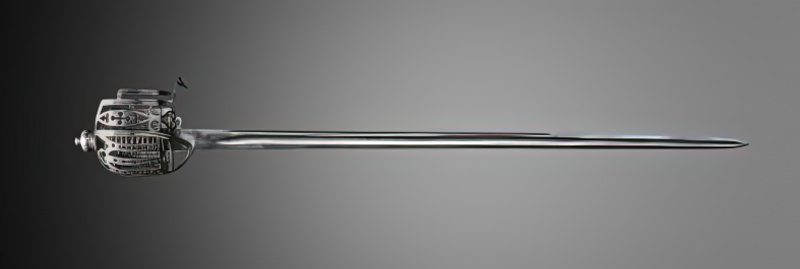
The Scottish Highlanders used their basket-hilted broadswords with their dirks or daggers. Their preference for light weaponry made these single-handed swords practical and efficient, especially since they often had to march for long distances.
Italian Schiavona
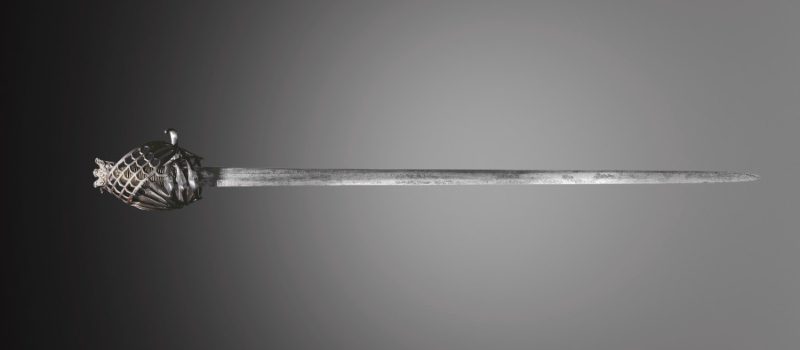
The name schiavona means Slavonic in Italian, referring to the Dalmatian troops who served the Venetian Republic. These Slavic soldiers were fierce warriors who fought the Ottomans and served as bodyguards to the Venetian doges, the highest official of the republic. The Venetian broadsword features the distinctive shape of a basket hilt and a cat’s head-shaped pommel, a reference to stealth and agility.
English Mortuary Sword

The term mortuary sword was a 19th-century collector jargon, likely due to its resemblance to the death mask of King Charles I of England, who was executed in 1649. Many believed they were supposed to commemorate the king. However, they seem to have gone out of fashion by 1670.
If this were true, the mortuary swords would have been used exclusively by the Royalists, supporters of King Charles I. However, it was also issued to the Parliamentary forces, as general Oliver Cromwell on the parliamentary side in the English Civil Wars against the king used it. More than that, their earliest examples date back to around 1635, dispelling their association with the English king.
Napoleonic Swords
By the time of the Napoleonic Wars, the light cavalry used curved sabres designed for cutting and slicing, while the heavy cavalry utilized long, straight, thrusting swords. For the infantry, the officers and senior noncommissioned officers continued to wear swords as symbols of rank.
Briquet Infantry Sabre

During the Napoleonic Wars, the infantry carried the briquet, named due to its resemblance to a fire striker. The grenadiers and the light infantry initially wore them but it later became limited to the grenadiers, carabineers, and other officers. The infantry also fought with bayonets and flintlock muskets.
U.S. Civil War Swords
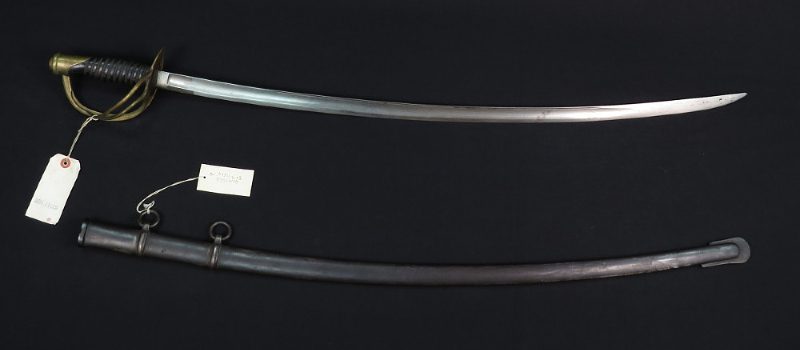
The classic American Civil War swords of the cavalry were the 1840 Heavy Cavalry Saber and the 1860 Light Cavalry Saber. The Model 1860 replaced the heavier Model 1840, nicknamed the Old Wristbreaker, as it was too heavy and clumsy to use. The two swords were identical, but the later version had a narrower blade and was efficient in thrusting and hacking.
The infantry officers on the Union side carried the Model 1850 Foot Officer’s Sword, but they rarely used it in actual combat.
7. Rapier
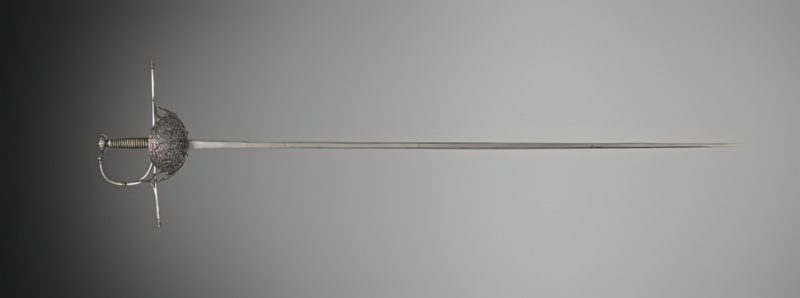
The term “rapier”, derived from the Spanish term espada ropera or sword of the robes, is the name of the sword that was known as the gentlemen’s sword during the 16th and 17th centuries. It was associated with dueling, court, and fashion, hence its tendencies toward delicate and intricate designs.
Rapiers are thrusting swords with very narrow blades. They also served as an efficient self-defense weapon for unarmored civilians. Italian rapiers often had swept-hilt designs, while Spanish ones had cup-hilt guards.
How to Choose the Best Antique Sword
Apart from its historical value, an antique sword should be in excellent condition, structurally sound, and aesthetically pleasing. Still, it takes years to train the eye on differentiating between a good and bad piece.
Here are the factors to consider when choosing an antique sword:
Metal and Construction
The type of steel used in antique swords differed from region to region. In Japan, samurai swords were made from tamahagane, produced from the tatara smelter using satetsu or iron ore in sand form. The Indian wootz steel was also traded in the Middle East and Europe to make damascus sword blades where some had a watery pattern design.
By the mid-13th century, the sword makers at Solingen in Germany were well-established and produced the best steel. By the 17th century, sword manufacturing became more industrialized and many European swords, including basket-hilted broadswords and mortuary swords, had German blades. Some rapiers also had blades made from Solingen in Germany or Toledo in Spain.
On the other hand, many U.S. Civil War swords were produced locally in Massachusetts and abroad. Modern sword reproductions are often hand-forged with quality carbon steel blades and look similar to antique swords. However, the value of antique swords is not based on how well-made or functional the piece is but rather on their cultural, historical, and artistic value.
Blade Appearance
Generally, sabers with curved blades were more suited to slashing from horseback while swords with straight blades were primarily used for stabbing. In some sword types, the shape of the blade, whether its curvature or point, reveals when it was made.
Blade Patterns
Some antique swords feature seemingly interesting patterns, but may be visible flaws or defects of forging errors. Generally, flaws devalue the antique blade. For example, open welds and gaps suggest the sword’s poor construction. However, there are also patterns that are artistic features of the blade.
Japanese Hamon

In Japanese swords, steel color, pattern, and features reveal their origin. The hamon or temperline pattern on the hardened edge serves as a signature and often points to an individual swordsmith or group of swordsmiths. Still, the hamon should not be interrupted by a chip or crack on the blade.
Wootz Steel Appearance
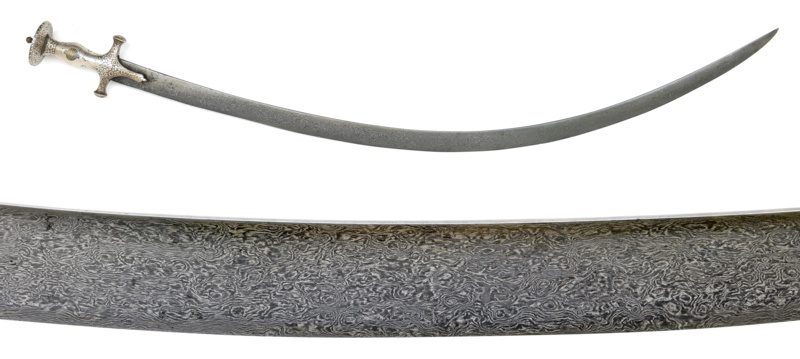
The ancient Indian wootz steel was mostly valued for its properties—not for its appearance. Many Indian swords often had polished bright blades, and the pattern was not visible. However, the Persians eventually developed an appreciation for wootz steel and started to make high-contrast blades with visible watery patterns.
Grooves and Carvings

Some antique swords have grooves to lighten the blade while others boast decorative carvings. Unlike Western-style engravings, the carvings on Japanese blades are called horimono and often have a three-dimensional character. The horimono designs range from talismans that imbue protective qualities to the weapon to traditional motifs such as Sanskrit characters, dragons, bamboo, and cherry blossoms.
Markings
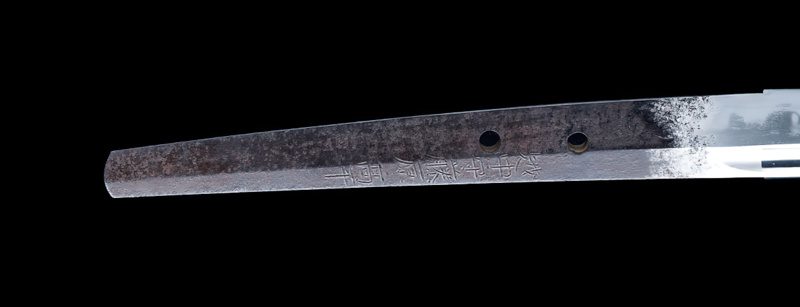
Sometimes, antique swords come with hallmarks, a smith’s mark, or signatures that identify where it was manufactured.
Japanese Mei or Signature
Some Japanese swords are signed on the tang, usually when they qualify to the standards of their makers. Still, it takes years for collectors to identify the swordsmith of a particular blade. However, forgeries are common, so collectors rarely rely on signatures on samurai swords.
Chinese Markings
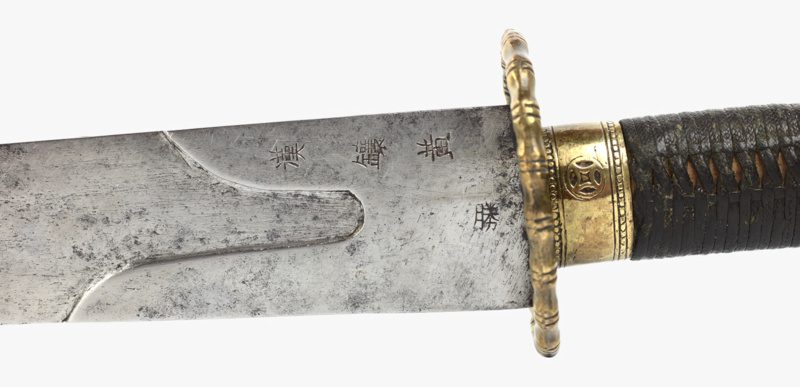
Some Chinese swords feature marks in the form of characters and serial numbers, but they are rare on the market. Many of these swords were likely held in military depots and were melted after the fall of the Qing to produce industrial steel.
Islamic Inscriptions
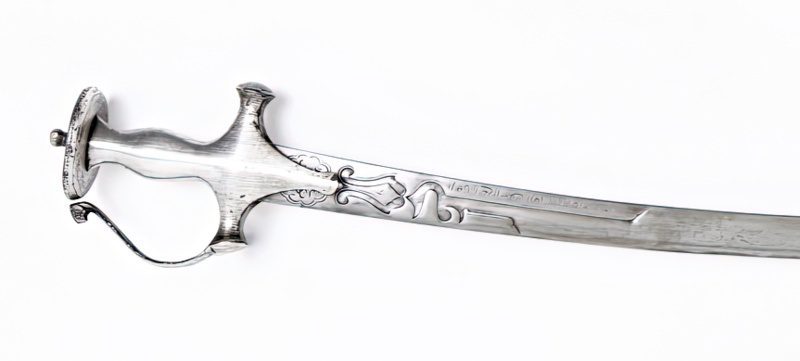
Some antique Islamic swords had inscriptions that served as a talisman for Muslim warriors. Many 18th-century talwars also had an inscription in Hindi and Urdu on the spine of the blade. Others had stamps, possibly maker’s marks on the blade surface.
Size and Length
Antique swords varied greatly in size depending on their use and purpose. The most widely collected nihonto is the Japanese katana which has a blade length of over 60 centimeters (23.6 inches). The shorter sword wakizashi measures between 30 and 60 centimeters long (11.8 – 23.6 inches), while tanto daggers have blade lengths under 30 centimeters (11.8 inches) long.
Historical Persian shamshir and Indian talwars usually had a blade length of more than 70 centimeters (27.6 inches) and an overall length of over 90 centimeters (35.4 inches). However, European hunting swords often had shorter blades, around 50 centimeters (19.7 inches) long. On the other hand, cavalry swords often had longer blades, as cavalrymen needed greater reach for slashing downward at their enemies.
Sword Mounting
Apart from the blade, an antique sword may boast the craftsmanship of its hilt, hand guard, scabbard, and other components. In some cases, it includes works of several artisans who made each part of the sword.
Hilt
Antique sword hilts widely vary in material, design, and construction. While Japanese swords have wooden grips, the Persian shamshir sometimes feature an ivory grip. However, re-hilting was a common practice in many cultures. Generally, old blades were treasured, but hilts were fashioned to suit the owner’s taste or the latest designs of the day.
Sword Guard
The sword guard protects the wielder’s hands with its form and design varying in different swords. Japanese sword collectors often focus on the tsuba or sword guard as many artisans created elaborate designs using precious metals and colored stones. By the mid-16th century, broadswords with basket hilts were widely used throughout Europe and developed into distinct regional styles. Rapiers also vary from swept-hilted to cup-hilted guards.
Scabbard
Scabbards are often damaged while protecting the blades and are often replaced. Antique Japanese swords may come in a shirasaya (plain, wooden scabbard) or a koshirae (decorative sword mounting) with a lacquered scabbard and other components.
Indian talwars also had wooden scabbards covered with leather or velvet and a metal chape that protects its end. Some Persian shamshirs also had highly decorative scabbards. On the other hand, many European and American cavalry swords had plain, wood-lined steel scabbards.
What Makes a Sword Antique?
According to various custom laws, an antique sword refers to those made at least 100 years ago, dating back to the 18th and 19th centuries or older. Some use the phrase military antiques to label their swords—though many of them may not qualify for the description. They might be old swords, but not as old as antiques and should be described as vintage swords.
Vintage swords are much younger, dating back to the early 20th century, usually from the 1930s to the 1960s, and so on. However, the antique and vintage scale changes as we move forward through the calendar. Antique swords in excellent condition are generally more valuable than vintage swords because of their history and age.
Still, the age of a sword does not directly correlate to its value. A vintage sword could also garner a higher value than a similar sword from an earlier period, especially if it comes from a reputable swordsmith or has a historical significance. The value of an antique sword could also depend on its type, quality, and origin.
How Much Is an Antique Sword Really Worth?
An antique sword in excellent condition is incredibly expensive, and it takes an expert to determine its value. Expert sword appraisers can help determine whether an antique blade is genuine or forged. The price may range from $300 to $6 million, depending on the sword type, condition of the piece, rarity, provenance, historical background, and the owner who once carried them.
For instance, the gold-encrusted sword Napoleon Bonaparte used at the Battle of Marengo in 1800 was sold for more than $6.4 million. It remains one of the most expensive antique swords sold on the market. Also, a 17th-century Indian talwar, believed to have belonged to Mughal emperor Shah Jahān, was sold for around $700,000.
Some collectors are interested in acquiring museum-quality masterpieces that once belonged to a well-known historical figure, while others opt for less expensive antique swords for their intrinsic beauty. Generally, collectors decide how much they want the piece and how much they are prepared to pay. Before investing in an antique sword, consider if it could retain or increase its value in the future.
Antique Japanese Swords vs. Antique European Swords
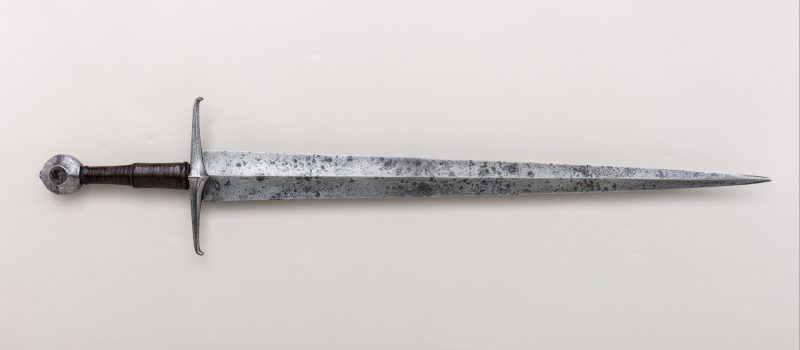
Japan has the most well-preserved swords in the world, as the Japanese regard them not just as weapons of war but also as artwork, status symbols, and representations of the soul of the samurai. It does not mean that European swords are less important, just that Western culture does not hold them in as high regard as the Japanese.
Antique Japanese swords are incredibly valuable and their owners have worked hard to preserve the ones they already own. The regulation of the manufacturing of Japanese swords and limited access to newly-made blades have also made the antique swords rarer. More than that, the Japanese regard swords as a significant part of their culture and works of art.
Apart from their historical value, nihonto or traditionally-made Japanese blades are prized for their intrinsic beauty, especially the hamon and hada. Sometimes auctioned as fine art pieces, Japanese swords and its fittings are also unique where its tsuba (sword guard) also became a collector’s item.
On the other hand, European swords are valued based on their historical value, such as what pattern or military used them. Their collectors are generally considered collectors of antiquity or militaria. Europe has valued Toledo swords for centuries, though never revered them as objects of worship.
Where to Get Antique Swords?
Many collectors obtained their antique swords from an auction. In London, all major auction houses hold sales of antique arms and armor while their associates in Canada and the United States hold similar sales. Large auction houses such as Sotheby’s and Christie’s are a reliable source of antique swords, though there is little chance of getting a real bargain.
Large auction houses often have facilities for researching and appraising antique swords. Some also offer lectures and online catalogs of collections. You may also ask museum or historical society personnel and other collectors for the names of reputable dealers who sell the type of antique swords you are collecting.
Some antique dealers set up their own auctions, though collectors must be careful from falling prey to unscrupulous auctioneers. Generally, reputable dealers are willing to refund the purchase price if they sell you a fake or forgery. Before making a purchase, consult experts who specialize in the type of sword you are interested in.
Care and Preservation of Antique Swords
Antique swords need to be cared for properly to prevent damages and rust. However, one must also be careful to avoid devaluing the piece.
Here are some ways to maintain your antique swords:
Take the antique sword to a professional polisher to remove the rust
Many simply use a mixture of oil and paraffin to loosen the rust which can be easily wiped off. However, stubborn rust will have to be removed by a polishing specialist as amateur repairs often scratch the blade surface and diminish its value. Also, some swords especially Japanese swords, are not supposed to have a bright and reflective surface and using buffers could overshine the blade.
Antique blades need cleaning and oiling every few months
Generally, a blade rusts easily after polishing and requires cleaning and oiling every ten days for about six months. Once the blade surface becomes more stable, it may only need cleaning every six months. Many simply oil the blade or wipe it with silicon dusters, though Japanese sword collectors often use specific tools for their blades.
When cleaning a Japanese blade, you may dust it with uchiko powder, a fine powder made from ground limestone, then wipe it with a clean flannel. Next, apply a thin coat of abura, sometimes called choji or clove oil on the blade surface. However, do not clean the tang of the sword, as it helps to authenticate the antique sword.
Sword mountings can be recovered or replaced
Metal scabbards can be easily cleaned, but ones with leather need careful handling. If the scabbard is old, it may contain dirt and rust that could damage the blade and should be replaced. The grips and sword guards could also be recovered or replaced, though it is not recommended to disassemble a sword, unless under the supervision of a professional.
Store the antique sword safely
Ideally, antique swords should be stored flat to prevent the oil from pooling. Many opt for sword display cases or drawers to keep their antique swords dust-free and protected. To prevent scratching the weapon, sword fittings should be covered with some form of plastic, or the case should have a fabric lining.
Many Japanese sword collectors store their blades in a plain wooden scabbard or shirasaya, instead of the elaborate koshirae, so they could easily split the scabbard into halves when cleaning, and could easily be fastened together with a paste.
Conclusion
When it comes to antique swords, there is too much to learn. Therefore, many collectors focus on a specific sword type, period, school, or geographical area when building their collection. Apart from historical value, they prize the craftsmanship and quality of antique swords. Some of the sought-after sword types include the Japanese swords, cavalry swords of the Napoleonic era and the American civil war, rapier, and other military swords.




